

There are both positive and negative reinforcements and punishments, and reinforcements are used to increase the repetition of a behaviour, while punishments do the opposite by discouraging the repetition of the behaviour.
This is a resource pack on what reinforcement and punishments mean for parents, and how they can use them to influence the behaviour of their teenage children.
What is Operant Conditioning?
What Is Operant Conditioning and How Does It Work?
Operant conditioning, sometimes referred to as instrumental conditioning, is a method of learning that employs rewards and punishments for behavior.
This is a summary of operant conditioning and the different types of operant conditioning. – callistael
Through operant conditioning, an association is made between a behavior and a consequence (whether negative or positive) for that behavior.1 For example, when lab rats press a lever when a green light is on, they receive a food pellet as a reward.
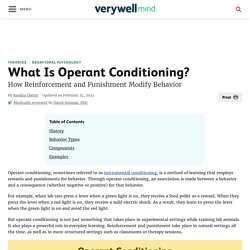
When they press the lever when a red light is on, they receive a mild electric shock. As a result, they learn to press the lever when the green light is on and avoid the red light. B.F. Skinner Operant Conditioning (Full video)
This provides an explanation about operant conditioning and the different types of reinforcement and punishment, as well as examples in an easy-to-understand video. – callistael
The difference between classical and operant conditioning - Peggy Andover.
This shows the difference between classical and operant conditioning, which gives an example of how it is used as well. – callistael
Operational Conditioning: Reinforcement and punishment.
A summary of the different reinforcements and punishments created by Crystal 🙂 – callistael
Positive Reinforcement. Parenting Children with Positive Reinforcement (Examples + Charts) Children don’t come with instructions and discipline is often experienced by parents and children alike as an arena where our will and wits are tested.
This explains and gives ideas on how to parent children of all ages, and it is a very comprehensive article that offers lots of insights into how one can incorporate positive reinforcement into their everyday lives. – callistael
Positive reinforcement is only one of many forms of discipline, but from the perspective of positive psychology, it may as well be the most important one as it focuses on amplifying what is already good in our children and in ourselves as their caretakers.

Positive reinforcement as a form of positive discipline allows us to tap into our children’s individual strengths, draw attention to their personality traits and interests, and as a result give us an opportunity to connect, communicate effectively, and ultimately empower them to be more of themselves. Positive Reinforcement and Operant Conditioning. In operant conditioning, positive reinforcement involves the addition of a reinforcing stimulus following a behavior that makes it more likely that the behavior will occur again in the future.
This is a summary of positive reinforcement and examples of how they can applied to real life situations. – callistael
When a favorable outcome, event, or reward occurs after an action, that particular response or behavior will be strengthened.
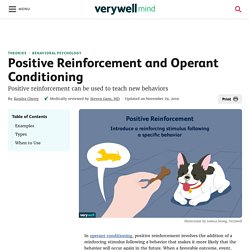
One of the easiest ways to remember positive reinforcement is to think of it as something being added. By thinking of it in these terms, you may find it easier to identify real-world examples of positive reinforcement. Sometimes positive reinforcement occurs quite naturally. For example, when you hold the door open for someone you might receive praise and a thank you. How to Reward Your Teen for Good Behavior. Teenagers are young adults who are trying to learn the ways of the world.
This gives a list of how to increase positive behaviour in teens via positive reinforcers such as extra curfew time and more tangible rewards such as the food they like, such as pizza. – callistael
When they do something great at school or at home or simply make a healthy decision, parents can give them a reward.

The reward does not have to be money, but it is a nice way to say "thank you" or "I'm proud of you. " Teens need this positive reinforcement because it shows them that they are on the right track.1 It is also a good life lesson that you can pass on: good things happen to good people. Positive Reinforcement - Tips for teaching and parenting.
This video gives a visual representation of how positive reinforcement can be used in a variety of situations, on both teens and oneself, in order to achieve desirable behaviours. – callistael
Youtube.
These are a few clips from a popular series, The Big Bang Theory. In it, they show how positive reinforcement can be applied to real-life situations, which in this case is offering a reward (chocolate) after each desired behaviour. They also briefly explain what positive reinforcement and operant conditioning are, with given context to the situation at hand. – callistael
Parenting Teens: When It Comes To Learning, Positive Reinforcement Trumps Punishment. Teens generally aren’t afraid to defy authority.
This study shows how teens may be more receptive to positive reinforcement as compared to punishment. – callistael
Generations of parents know this, having tried different strategies for getting their adolescents to do what they ask — often in attempts to keep them safe and help pave a path toward success.

Now, a new study shows that rewards, rather than punishments, could be the way to get them to cooperate. Negative Reinforcement. Negative Reinforcement and Operant Conditioning. Negative reinforcement is a term described by B.
This is a summary of negative reinforcement and examples of how they can applied to real life situations. – callistael
F.
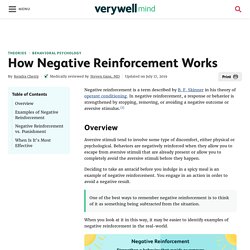
Skinner in his theory of operant conditioning. In negative reinforcement, a response or behavior is strengthened by stopping, removing, or avoiding a negative outcome or aversive stimulus.1 Overview Aversive stimuli tend to involve some type of discomfort, either physical or psychological. Negative Reinforcement: What Is It and How Does It Work? What is negative reinforcement?
This explains what negative reinforcement is and how it differs from other methods of operant condtioning – callistael
Negative reinforcement is a method that can be used to help teach specific behaviors.
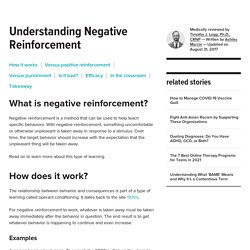
With negative reinforcement, something uncomfortable or otherwise unpleasant is taken away in response to a stimulus. Over time, the target behavior should increase with the expectation that the unpleasant thing will be taken away. Read on to learn more about this type of learning. The relationship between behavior and consequences is part of a type of learning called operant conditioning. Negative Reinforcement and Operant Conditioning. Did you know that parents could train their children to act defiant?
This talks about negative reinforcement and how it may be wrongly used in certain cases to produce an opposite result from intended, such as when the reinforcement is inconsistent. – callistael
“Who in their right minds would do that?”
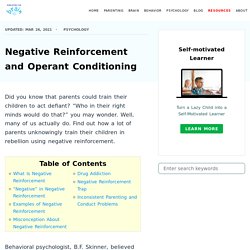
You may wonder. Well, many of us actually do. Find out how a lot of parents unknowingly train their children in rebellion using negative reinforcement. Behavioral psychologist, B.F. Negative reinforcement: Definition and examples. Negative reinforcement encourages specific behaviors by removing or avoiding negative consequences or stimuli.
This explains what positive and negative reinforcement is, and how they differ from punishments. – callistael
It is different than punishment, which aims to discourage a specific behavior.
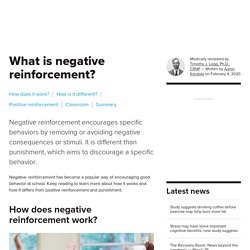
Negative reinforcement has become a popular way of encouraging good behavior at school. Keep reading to learn more about how it works and how it differs from positive reinforcement and punishment. Negative reinforcement is the encouragement of certain behaviors by removing or avoiding a negative outcome or stimuli. Positive Punishment. Positive Punishment and Operant Conditioning. Positive punishment is a concept used in B.F.
This is a summary of positive punishment and examples of how they can applied to real life situations. – callistael
Skinner's theory of operant conditioning.

How exactly does the positive punishment process work? The goal of any type of punishment is to decrease the behavior that it follows. In the case of positive punishment, it involves presenting an unfavorable outcome or event following an undesirable behavior. When the subject performs an unwanted action, some type of negative outcome is purposefully applied. How to Use Essays as Positive Punishment For Children and Teens by ParentTools.
This bite-sized video gives an example of how positive punishment can be used, as it needs to be targeted to the problem itself. An essay would help them reflect on what they did wrong and be a step in changing their behaviour for the better. – callistael
12 Examples of Positive Punishment & Negative Reinforcement. You might be thinking that “positive punishment” sounds like an oxymoron, after all, how can punishment be positive? Not many people “like” punishment, right? The disconnect in understanding this concept comes from the usage of the word “positive;” here at PositivePsychology.com, we generally use the term “positive” to refer to things that are inherently good, things that are life-giving, and things that promote thriving and flourishing. The concept of positive punishment comes from a very different era and a very different perspective on psychology; namely, the 1930s and behaviorism.
So, what actually is positive punishment and how does it relate to parenting, teaching, and even the workplace? Before you read on, we thought you might like to download our 3 Positive Psychology Exercises for free. Negative Punishment. How Negative Punishment Works. Negative punishment is an important concept in B.
This is a summary of negative punishment and examples of how they can applied to real life situations. – callistael
F. Skinner's theory of operant conditioning. References.